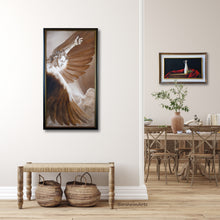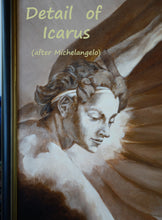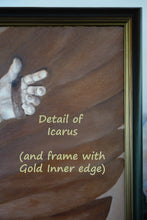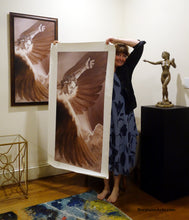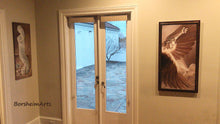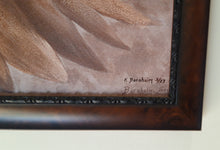
- Giclee fine art print
- Choice of TWO sizes: 40 x 20 inches OR 50 h x 25 inches
- The 50-inch tall giclee is NOT framed and ships unmounted, rolled in a tube)
- The 40-inch tall giclee offers three choices:
- Unframed and rolled in a tube to you
- Framed with the black carved inner liner on a dark wood frame
- Framed with a dark wood frame with gold inner liner
- Free shipping
- Available from artist Kelly Borsheim
"The Triumph of Icarus"
The first time I heard about the Greek legend of Icarus, I felt lectured: Do not try to get to heaven (or disobey your parent?) or you will fail and die. As the story goes, Daedalus and his young son Icarus were imprisoned by King Minos in a tower on the island of Crete, guarded heavily by surrounding sea vessels. The inventor Daedalus devised an escape by air by creating wings made from feathers and wax, but warned his son not to fly too high or the wax would melt, nor too low or the moisture from the sea would dampen and clog the wings. But during the flight, up in the air, filled with the thrill of flying, Icarus forgot his father's warnings and soared closer to the sun. The beeswax melted, destroying his means of flight, and he plunged to his death in the sea below.
But what really was his crime that was worthy of such consequences? You cannot say it was too much ego or pride, for it was his clever father Daedalus, not Icarus, who came up with the idea and fashioned the wings made from the available materials.
Best I can tell, Icarus was guilty of forgetting the seriousness of his situation and living in the moment, of pursuing joy and exaltation. Youthful folly, if you will. Almost all of the art I have ever seen created about Icarus, who ironically became more famous than his inventor father, portrays the boy's fall from the skies. (Isn't it odd that Daedalus would attempt to escape during the bright visibility of the day? But then, we would have no story . . . ) Wildly ineffective wings are often depicted in a near-vertical position above Icarus's body to portray his rapid descent into the ocean, to his impending death.
But I was always intrigued by that transitory interval, no matter how brief, in which Icarus was one with his environment. That quiet moment that he had to himself to realize, "Wow, I am really here. And it is amazing."
How many of you have wanted to fly like a bird, to feel that freedom of riding with the wind? It is our fascination with the unknown and the inexperienced that causes us to take great risks. And that is part of why Icarus has remained immortal to us. [And ironically, the patron saint of pilots!]
So now you know most of my thoughts while creating my painting, The Triumph of Icarus. This painting of Icarus in flight, in that moment of wonder and curiosity, consists of warm browns and subtle oranges, with some metallic colors added to enhance the glow of the light touching the face of Icarus.
The face of Icarus is actually painted after Michelangelo, one of his sibyls.
The original painting sold immediately, decades ago. I had only 4 x 5 inch film transparencies of my artwork. Sadly, those were stolen by the print shop who had them for making giclee when they went out of business and disappeared without a word. Thus, all I have are a limited amount of prints on canvas made long ago. Once they are gone, they are gone.
Two of those limited edition prints are framed and available here.
Contact The Artist About This Artwork
The Legend of Icarus
(Compiled from various Web sites):
One of the better known stories in Greek mythology is that of Daedalus and Icarus. Icarus was the son of the Daedalus and a slave named Naucrate. Daedalus was an Athenian inventor and architect. Legend says he invented tools, such as the saw and the ax. He is considered by some to be the forefather of the engineer. However, the legend also attributes to Daedalus a strong jealousy of anyone who showed signs of a talent for mechanical cleverness. He even reportedly killed a nephew who he considered potential competition. As punishment, Daedalus was banished to the island of Crete.
In the meantime, King Minos of Crete had been having his own problems. The god of the sea, Poseidon had given King Minos the gift of a beautiful snow-white bull to offer up as a sacrifice. But the king was greedy and coveted the bull, refusing to obey Poseidon's request. Instead, King Minos sacrificed a fake bull in an attempt to fool the god of the sea. As retribution, an angry Poseidon made Mino's wife Pasiphae fall in love with the bull. (Ya gotta love these myths!) The result of this union (with the aid of clever Daedalus. Now, there's a funny story - look it up) was the Minotaur, a creature with a man's body but a bull's head. Once again, the apparently moral-free Daedalus was called upon to help. He built the famous Labyrinth for King Minos, to hide the hideous bullman.
The Labyrinth was a maze of twisting corridors from which nothing could escape. It consisted of "numberless winding passages and turnings opening into one another, and seeming to have neither beginning nor end, like the river Maeander, which returns on itself, and flows now onward, now backward, in its course to the sea." King Minos was an efficient man and got plenty of use out of his Labyrinth. Not only did he imprison his wife's monster son, the Minotaur, but he also used the maze to enslave his enemies and feed the beast.
The son of King Minos died accidentally in Athens and as retribution, the king demanded that every nine years, Athens deliver seven youths and seven maidens for the king of Crete to sacrifice to his Minotaur. However, his daughter Ariadne fell in love with Theseus, one of the Athenians brought to Minos for sacrifice. Ariadne sought out the Athenian creator of the Labyrinth for help in saving Theseus and Daedalus told her to have Theseus unroll a ball of twine as he entered the Labyrinth so that he could later find his way out. Theseus entered the Labyrinth, slayed the Minotaur, and escaped successfully, taking Ariadne with him.
Some accounts say that Daedalus and his son Icarus were imprisoned in the tower of the Labyrinth to ensure that the inventor would not reveal the secret of the maze. Others say that once the king deduced the role of Daedalus in the escape of Theseus with his daughter Ariadne, he imprisoned Daedalus and Icarus in the tower as punishment.
Daedalus did not accept this and began to plan his escape from the isle of Crete. Daedalus knew that the king controlled any escape routes by land or sea, "but not the regions of the air. I will try that way." So Icarus helped his father gather up feathers which the wind has blown their way and Daedalus fastened them together with wax. The two practiced flying with their new wings before actually leaving the tower. On the day of the escape, the father fitted the wings on the boy and cautioned, "Icarus, my son, I charge you to keep at a moderate height, for if you fly too low the damp will clog your wings, and if too high the heat will melt them. Keep near me and you will be safe."
Daedalus kissed Icarus, not knowing it was for the last time. Then he flew off, and looked back to see how his son was doing. As they neared land, people on the ground looked up and thought they saw gods flying above them.
"They passed Samos and Delos on the left and Lebynthos on the right, when the boy, exulting in his career, began to leave the guidance of his companion and soar upward as if to reach heaven. The nearness of the blazing sun softened the wax which held the feathers together, and they came off. He fluttered with his arms, but no feathers remained to hold the air. While his mouth uttered cries to his father it was submerged in the blue waters of the sea, which was thenceforth called by his name. His father cried, "Icarus, Icarus, where are you?" At last he saw the feathers floating on the water, and bitterly lamenting his own arts, he buried the body and called the land Icaria in memory of his child. Daedalus arrived safe in Sicily, where he built a temple to Apollo and hung up his wings, an offering to the god."
"He buried his son on an island which would be called Icaria, and the sea into which Icarus had fallen would ever after be called the Icarian Sea (between the Cyclades and Asia Minor). "
"It is the Icarus figure itself, and the legend of his tragic flight, which stands as a symbolic recognition of all downed airmen."












